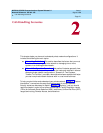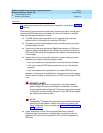
MERLIN LEGEND Communications System Release 6.1
Network Reference
555-661-150
Issue 1
August 1998
Call-Handling Scenarios
Page 2-9Networking Guidelines
2
SYS PROGRAM➙LINES/TRUNK➙REMOTE ACCESS➙NONTIE/TIELINES➙
RESTRICTIONS
When programming the default COR, change the Calling Restriction option to
unrestricted (the factory setting is outward restricted). You should assign
Disallowed List 7 to include; 900, 976, and other types of calls that users should
not be allowed to call. When a call is received at a non-local system that routes it
to another private network system, the FRL assigned to the default COR is
compared to the local UDP or ARS route FRL to permit or forbid the routing of the
call. For a call to go through, the route FRL must be equal to or less than the
default COR FRL. These considerations are discussed in detail in Chapter 4,
“Security.”
To make it easier for users working away from their home system in a private
network and for maintenance and toll-saving purposes, you can include non-local
systems’ Remote Access codes in your non-local dial plan. Each networked
system should have a unique, unambiguous Remote Access code. These
numbers must not conflict with extension ranges in the networked systems’ non-
local dial plans. Calls to the remote access extension that require barrier codes
use the COR assigned to the barrier code entered.
SECURITYlALERT:
!
Networked systems require special attention to security issues. Follow the
rules below when setting up and planning your system for private network
use.
■
Ensure that barrier codes are required for incoming remote access
calls received on PSTN dial-plan routed and tandem facilities that
route to the Remote Access code (889, for example). When you
program the default COR, turn the barrier code requirement on. This
setting is ignored for ARS calls and calls to non-local extensions
across the private network. However, it is still applied to DID and
PRI dial-plan routed remote access calls as well as to calls received
on a tandem trunk and routed to a Remote Access code. Because
the COR Calling Restriction must be set to unrestricted for private
network calling, using barrier codes on these facilities is essential in
order to apply security measures. When a Remote Access code is
included in the non-local dial plan of the calling system, the caller’s
barrier code FRL on the called system is compared to the UDP or
ARS route FRL on the called system. See the
Feature Reference
and “Remote Access Default Class-of-Restriction Settings” on page
6 for details.
■
Extension and ARS FRLs should be carefully and stringently
assigned in order to prevent unauthorized trunk-to-trunk transfers to
local PSTN facilities. Table 4–1, page 4-3
explains the operation of
this feature in a networked system.


















